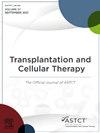Phase II Trial of Allogeneic Hematopoietic Cell Transplantation for Mature NK/T Cell Neoplasms – Potent Graft Vs Tumor Effect Affords Remission Even with Refractory Disease
IF 3.6
3区 医学
Q2 HEMATOLOGY
引用次数: 0
Abstract
Introduction
Peripheral (mature) T and NK-cell lymphomas (PTCL) are aggressive and poorly responsive to chemotherapy. Allogeneic hematopoietic cell transplantation (alloHCT) is a potentially curative cellular immunotherapy. Unfortunately, alloHCT remains understudied prospectively. Herein, we present the results of a prospective trial of alloHCT for PTCL.
Methods
This single-center, prospective phase II trial (NCT03922724) is being conducted at the NIH from April 18, 2019 to present. The data from all patients enrolled and evaluable through August 23, 2022 are included. Patients received reduced-intensity conditioning (RIC) incorporating distally-timed horse antithymocyte globulin, pentostatin, low-dose, hyperfractionated cyclophosphamide and 2-days of busulfan, followed by a T-cell replete PBSC graft, with PTCy, MMF, and sirolimus for GVHD prophylaxis. GCSF was given on day -12, -8, and -4 in a subset of patients (n=10, mRIC arm) and compared to the prior 21 patients (RIC arm). Endpoints included progression-free survival (PFS), overall survival (OS), cumulative incidences (CuIs) of acute GVHD (aGVHD), chronic GVHD (cGVHD), progression/relapse, and transplant-related mortality (TRM).
Results
Patients transplanted (n=31) were high-risk, in disease subtype, HCT-CI scores, and disease status at HCT (Fig 1). With median follow-up of 3.5 years for surviving patients, 1-year PFS was 53% (95% CI 29-72%) for the RIC arm and 60% (95% CI 25-83%) for the mRIC arm. For the whole cohort, the estimated 3-year PFS was 52% (95% CI 33-68%), with 3-year OS of 61% (95% CI 42-76%). The 3-year CuI of relapse was 18% (95% CI 6-34%) (Fig 2A), with 100-day and 1-year Cul of TRM of 17% (95% CI 6-32%) and 24% (95% CI 10-41%) respectively (Fig 2B). The Cul of TRM at 1 year was 11% (95% CI 2-29%) for patients ≤60 years but 56% (95% CI 17-82%) for patients >60, p=0.011 (Fig 2C). No patients developed grade III-IV aGVHD. The 1-year Cul of grades II-IV aGVHD was 16% (95% CI 6-31%) in all patients. The 2-year CuI of cGVHD was 23% (95% CI 10-39%) with 2-year Cul of 30% (95% CI 6-60%) for recipients of HLA-matched grafts and 19% (95% CI 5-39%) for recipients of HLA-mismatched grafts. Immune reconstitution was robust overall with 90% of surviving, engrafted patients having CD4+ T cells > 50 cells/uL by day +100. Immune subset recovery to normal levels was reached by day +60 for NK cells (Fig 3A), day +180 for CD8+ T Cells (Fig 3B), day +100-180 for B cells (Fig 3C), and 2 years for CD4+ T Cells (Fig 3D).
Conclusions
Despite most patients being transplanted with high-risk, active disease, and significant comorbidities, outcomes were promising, providing compelling justification for the role of alloHCT in PTCL, even when remission is not obtained pre-HCT. The prospective study of alloHCT for PTCL is ongoing at NCI, aiming to decrease early TRM in older patients and further harness the graft-versus-tumor effect to afford cure and good survivorship.
同种异体造血细胞移植治疗成熟NK/T细胞肿瘤的II期试验-有效的移植物Vs肿瘤效应即使对难治性疾病也能提供缓解
外周(成熟)T细胞和nk细胞淋巴瘤(PTCL)具有侵袭性,对化疗反应较差。同种异体造血细胞移植(Allogeneic hematopoietic cell transplantation, alloHCT)是一种具有潜在疗效的细胞免疫疗法。不幸的是,alloHCT的前瞻性研究仍然不足。在此,我们提出了一项针对PTCL的同种异体hct前瞻性试验的结果。该单中心前瞻性II期试验(NCT03922724)于2019年4月18日至今在NIH进行。纳入截至2022年8月23日的所有入组和可评估患者的数据。患者接受低强度调节(RIC)治疗,包括远时马抗胸腺细胞球蛋白、戊他汀、低剂量、高分级环磷酰胺和2天的丁硫凡,随后进行t细胞填充PBSC移植,PTCy、MMF和西罗莫司用于GVHD预防。在一组患者(n=10, mRIC组)的-12、-8和-4天给予GCSF,并与之前的21例患者(RIC组)进行比较。终点包括无进展生存期(PFS)、总生存期(OS)、急性GVHD (aGVHD)、慢性GVHD (cGVHD)的累积发病率(CuIs)、进展/复发和移植相关死亡率(TRM)。结果移植患者(n=31)在疾病亚型、HCT-CI评分和HCT疾病状态方面都是高风险的(图1)。存活患者的中位随访时间为3.5年,RIC组的1年PFS为53% (95% CI 29-72%), mRIC组的1年PFS为60% (95% CI 25-83%)。对于整个队列,估计3年PFS为52% (95% CI 33-68%), 3年OS为61% (95% CI 42-76%)。3年复发的CuI为18% (95% CI 6-34%)(图2A), 100天和1年的TRM Cul分别为17% (95% CI 6-32%)和24% (95% CI 10-41%)(图2B)。≤60岁的患者1年TRM的Cul为11% (95% CI 2-29%),而≤60岁的患者为56% (95% CI 17-82%), p=0.011(图2C)。没有患者发展为III-IV级aGVHD。所有患者II-IV级aGVHD的1年Cul为16% (95% CI 6-31%)。cGVHD的2年CuI为23% (95% CI 10-39%), hla匹配移植受体的2年Cul为30% (95% CI 6-60%), hla不匹配移植受体的2年Cul为19% (95% CI 5-39%)。总体而言,免疫重建是稳健的,90%存活的移植患者具有CD4+ T细胞;50 cells/uL / day +100。NK细胞+60天(图3A), CD8+ T细胞+180天(图3B), B细胞+100-180天(图3C), CD4+ T细胞2年(图3D),免疫亚群恢复到正常水平。尽管大多数移植患者伴有高风险、活动性疾病和显著的合并症,但结果是有希望的,这为同种异体hct在PTCL中的作用提供了令人信服的理由,即使在hct前没有获得缓解。NCI正在进行同种异体hct治疗PTCL的前瞻性研究,旨在减少老年患者的早期TRM,并进一步利用移植物抗肿瘤效应来提供治愈和良好的生存率。
本文章由计算机程序翻译,如有差异,请以英文原文为准。
求助全文
约1分钟内获得全文
求助全文
来源期刊

Transplantation and Cellular Therapy
Medicine-Hematology
CiteScore
7.00
自引率
15.60%
发文量
1061
审稿时长
51 days
 求助内容:
求助内容: 应助结果提醒方式:
应助结果提醒方式:


